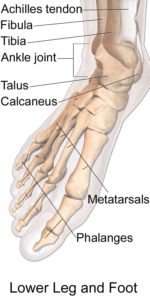Blog
I’ve Fractured My Ankle… How Can Physiotherapists Help Manage This?
I’ve recently fractured my ankle… I don’t know how to use crutches and I’m not sure what I should or should not be doing…
Ankle fractures (aka broken ankle), can occur after a severe ankle sprain, a fall or severe trauma such as being in a car accident.
Let’s talk about the anatomy of the ankle first. There are 3 bones which make up your ankle joint (talocrural joint):
- Tibia (the shin bone)
- Fibula (the smaller bone in your lower leg)
- Talus (a smaller bone on top of your heel bone [calcaneus])
Some symptoms of an ankle fracture include:
- Swelling
- Bruising
- Immediate onset of severe pain
- Being unable to weight-bear on the affected foot
It is important to seek the help of a health professional (doctors, physiotherapists) if you have had a severe ankle sprain, as this may sometimes lead to ankle fractures.
Treatment
Depending on the severity of your injury, your ankle joint may or may not be stable.
Surgical intervention
An unstable ankle fracture may suggest that you would require surgical intervention to reduce the dislocation and have the bones held together with rods and screws, and sometimes plates. The necessity of a surgery will be determined by an orthopaedic surgeon.
Conservative (non-surgical) management
This means your ankle/lower leg will be put in a cast or a brace to prevent further movement of the ankle joint. Usually you will remain in the cast for 6 weeks, although a recent research has shown that as little as 3 weeks of management in the cast may not be inferior than the usual approach. Click here to find out more about this.
Your doctor will determine whether it is safe for you to put weight through the injured leg, again depending on the severity of your injury
Not sure how to use crutches?
Have a look at this video below to find out how to use crutches in a safe manner!
Whilst you are in the cast, you would benefit from general exercises such as:
- maintaining range of motion of your adjacent joints (knee/hip).
- circulation exercises to prevent the risk of developing a DVT (deep vein thrombosis)
- deep breathing exercises to help maintain your lung function
Once your doctor has decided it is time to remove the cast/brace, you most likely will be referred to see a physiotherapist to help you regain function of your affected limb as you may have been out of action for weeks!
Physiotherapy intervention after immobilisation
As you have been in a cast/brace for a number of weeks, the ankle joint becomes less mobile and the muscles in your leg weaken. Balance is sometimes a problem for people with ankle fractures.
Physiotherapists can help you by:
- Providing joint glides to increase your range of motion
- Prescribing a series of strengthening exercises for your lower limb muscles, such as a theraband-resisted exercises, heel raises
- Giving you a balance program to help you regain the ability to put weight through the injured leg, and also improve your balance
Give us a call on 1800 800 118 or email us on [email protected] if you have any burning questions, or if you would like to book in an appointment to see one of our physiotherapists today!
References
Ankle Fractures (Broken Ankle) – OrthoInfo – AAOS. (2019). Retrieved from https://orthoinfo.aaos.org/en/diseases–conditions/ankle-fractures-broken-ankle
Deep vein thrombosis. (2019). Retrieved from https://www.healthdirect.gov.au/deep-vein-thrombosis


